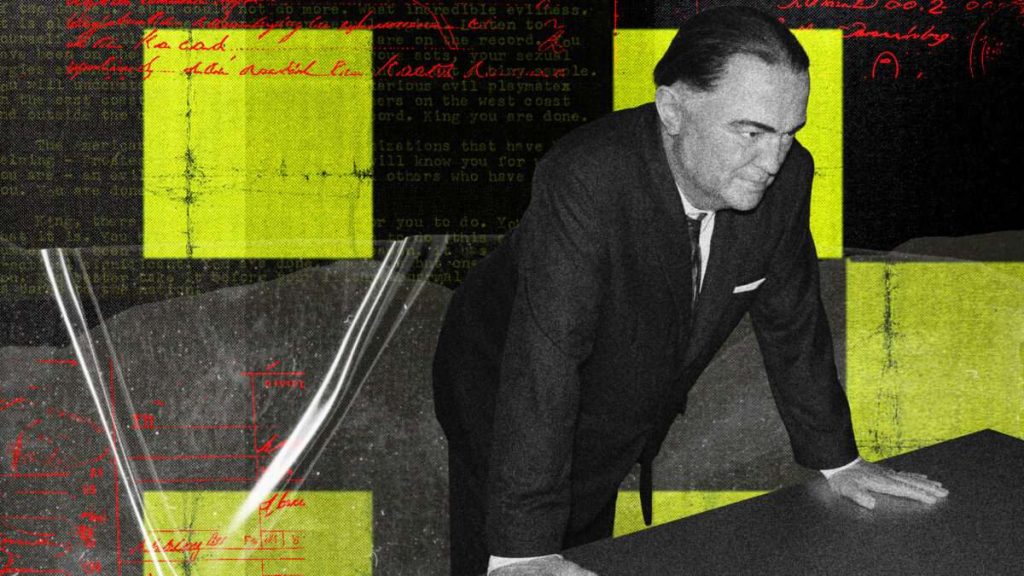On May 10, 1924, one of the worst events in history for American civil liberties happened: 29-year-old J. Edgar Hoover assumed the role of director of the then-Bureau of Investigation. Ambitious, power-hungry, and conniving, Hoover epitomized the snake in the proverbial garden. Under his watch, which lasted until his death in 1972, the FBI emerged as an alarming adversary to constitutional freedoms.
Starting his career at the Justice Department in 1917 at only 22 years old, Hoover quickly ascended the ranks, often at the expense of Americans’ civil liberties. By 1919, he headed the Justice Department’s Radical Division, charged with destroying the supposed communist infiltration of America. Hoover’s lifelong disdain for communists was matched only by his disregard for their constitutional rights, making this role a perfect fit for his ambitions.
Hoover Cuts His Unconstitutional Teeth
As head of the Radical Division, Hoover began developing the dirty tricks he would become known for, relying on tactics fundamentally at odds with a free society. For example, he started compiling the secret files that made him infamous and feared by the political elite. “What Hoover accomplished during his first months at the Radical Division forever changed the nature of American politics,” writes Beverly Gage in G-Man: J. Edgar Hoover and the Making of the American Century, “launching an unprecedented experiment in peacetime political surveillance.”
Under Hoover’s leadership and fueled by the Espionage Act of 1917, federal agents aggressively pursued radicals—communists, socialists, and anarchists—tapping their phone lines and intercepting their mail. Hoover amassed more power, and at the tender age of 24, according to Tim Weiner in Enemies: A History of the FBI, Hoover “could call for the arrest of almost anyone he chose.”
In April 1919, a coordinated anarchist campaign of mail bombs targeted prominent Americans, including Hoover’s boss, Attorney General A. Mitchell Palmer. Though none of the bombs met their intended targets, the first Red Scare was on.
Hoover answered by organizing what became known as the Palmer Raids, with the initial raid in November 1919 leading to the mass arrests of nearly 1,200 suspected radicals—far more people than Hoover secured warrants for. Many rotted in city and county jails for months, and nearly 200 were deported under the Anarchist Exclusion Act of 1918.
But it was Hoover’s encore the following January that epitomized what would become his lasting legacy: utter disregard for constitutionally protected rights. Beginning at 9 p.m. on January 2, 1920, Hoover led the largest mass arrests in American history. The raids continued into the week, and thousands were detained indiscriminately, many without warrants or just cause.
According to Weiner in Enemies, “somewhere between 6,000 and 10,000 people were swept up in the raids.” However, he notes that we will likely never know the exact number as “no official accounting ever took place.”
Rather than landing Hoover behind bars or at least ending his career, he evaded accountability and mastered the art of bureaucratic survival that protected him through eight presidential administrations. Before long, he was rewarded. On May 10, 1924, Attorney General Harlan Fiske Stone named Hoover acting director of the Bureau of Investigation. Stone was a believer in civil liberties, notably, and told Hoover he was on probation and that the Bureau was out of the secret police game.
But Hoover would have the last laugh. Soon after, he revived his domestic intelligence operations and unconstitutional ways, often operating beyond public and political accountability scrutiny.
Friends in High Places
Presidential administrations throughout the 20th century—likely fearing Hoover and his secret files—left him unchecked and either actively supported or tacitly approved of his methods. Presidents from Franklin Delano Roosevelt to Richard Nixon found Hoover’s capabilities useful for their political agendas, thus embedding a culture of surveillance and political manipulation that Hoover masterfully orchestrated.
“He wasn’t acting on his own,” writes FBI Special Agent Paul Letersky in The Director: My Years Assisting J. Edgar Hoover. “Since before World War II, every president he’d served—those revered by the left and those revered by the right—knew what Hoover and the Bureau were doing in domestic security and surveillance.”
During the run-up to World War II, FDR turned Hoover loose, empowering the FBI director to return to gathering intelligence on American fascists and communists. Hoover revived secret warrantless wiretapping only two years after Congress banned it in the Communications Act of 1934.
With war breaking out in Europe, Hoover’s worries about internal subversion grew. On December 6, 1939, Hoover issued his agents a secret (read: unauthorized) order named “Internal Security.” The agents were to begin compiling a list of “dangerous” people—not just immigrants but also American citizens—to be detained when the war came to American shores.
The list was known as the Custodial Detention Program. It categorized people into three groups (A, B, and C), with people in Group A considered to be the most dangerous—if war broke out, they would be arrested and detained immediately. One conspicuous name in Group A was Roger Baldwin, one of the founders of the American Civil Liberties Union and its current chief.
Attorney General Francis Biddle learned about the Custodial Detention Program in 1943 and ordered it shuttered. Hoover simply renamed it the Security Index. It would remain secret until after Hoover’s death, growing to include well over 20,000 names, almost all Americans.
But no matter how many laws or norms Hoover broke, he continued atop his powerful perch at the FBI. President Harry Truman didn’t like Hoover. In the words of his Treasury Secretary John Snyder, Truman believed “Mr. Hoover had built up a Frankenstein in the FBI.”
John F. Kennedy—like his brother, Attorney General Robert Kennedy—wanted to send Hoover packing. Bobby Kennedy said Hoover was “frightening” and called the FBI “a very dangerous organization.” But JFK ultimately concluded, “You don’t fire God.”
Hoover, if nothing else, was a survivor.
Seeing Red Again
Perhaps the most infamous example of Hoover’s brazen attacks on American civil liberties was the Counterintelligence Program (COINTELPRO). Initiated in 1956, COINTELPRO’s operations were characterized by illegal surveillance, organizational infiltration, and police harassment. With this tool in place, Hoover shifted his concentration to a new enemy: the civil rights movement and its leader, Martin Luther King Jr.
Hoover believed the Soviets—not black Americans fed up with segregation and racial injustice—were behind the civil rights movement. He also believed King was a Moscow stooge, which landed him on the Security Index.
The FBI’s disdain for the civil rights movement was so visceral that agents would tip off police in Alabama about the plans of the Freedom Riders, a contingent of black and white demonstrators protesting Jim Crow laws. Freedom Riders were often met with overwhelming violence by both police and the Ku Klux Klan, who had also thoroughly infiltrated the Alabama police.
In arguably the FBI’s most infamous COINTELPRO operation, agents bugged MLK’s hotel rooms as he traveled. The preacher had his own dark side. The bugs would frequently pick up the sounds of sex after late-night parties. In an effort to destroy King for good in November 1964, Hoover’s intelligence chief sent the sex tapes to King’s wife with a letter that gave him an ultimatum—suicide or disgrace. Its conclusion read:
King, there is only one thing left for you to do. You know what it is. You have just 34 days in which to do…You are done. There is but one way out for you. You better take it before your filthy, abnormal fraudulent self is bared to the nation.
It would take the rifle of James Earl Ray to do what the FBI couldn’t—end King’s life.
Hoover’s corruption extended into his personal realm, too. He maintained a luxurious lifestyle, heavily subsidized by the FBI’s budget and, therefore, the American taxpayer. “The Bureau provided with him chauffeurs, handymen, gardeners, valets, and the tax accountants who sorted out the honoraria he received, totaling tens of thousands of dollars, from corporate grandees,” explains Weiner in Enemies. “The gifts, given for ghostwritten speeches and articles, and as private awards for public service, supplemented the freely spent tax dollars that financed Hoover’s four-star style.”
On May 2, 1972, Hoover’s heart gave out in his sleep. While this ended his reign of terror, Hoover’s methods and the culture he cultivated within the FBI have left a lasting imprint on American law enforcement and intelligence practices. Libertarians often describe government as a form of organized crime. Hoover’s godfather-like dominion over the FBI makes that comparison harder to dismiss.
A Man of Zeal
In his dissent in Olmstead v. U.S., which coincidentally legalized government wiretapping for a short time, Justice Louis Brandeis wrote: “The greatest dangers to liberty lie in insidious encroachments by men of zeal, well-meaning but without understanding.”
And therein lies the danger of men like Hoover. To give the devil his due, Hoover most certainly believed plunging his hands into the latrine was necessary to defend the country he loved from those he thought would destroy it. As Letersky writes in The Director, Hoover was “a man who in his sincere belief that he was protecting his country had repeatedly violated the principles of the Constitution on which the country was founded.”
The 100th anniversary of Hoover’s rise to power should serve as a reminder that the FBI—and the national security state it exemplifies—remains a dagger pointed at the heart of American civil liberties. All the Bureau needs to break bad again is another man “of zeal, well-meaning but without understanding” to return to Hoover’s dirty tricks.
There is no greater domestic threat to American freedom than a secret police. Hoover proved that for five decades until the devil called him home. May his ghost never wander the FBI’s halls.
The post An American Gangster at 100: J. Edgar Hoover’s Authoritarian Legacy appeared first on Reason.com.







